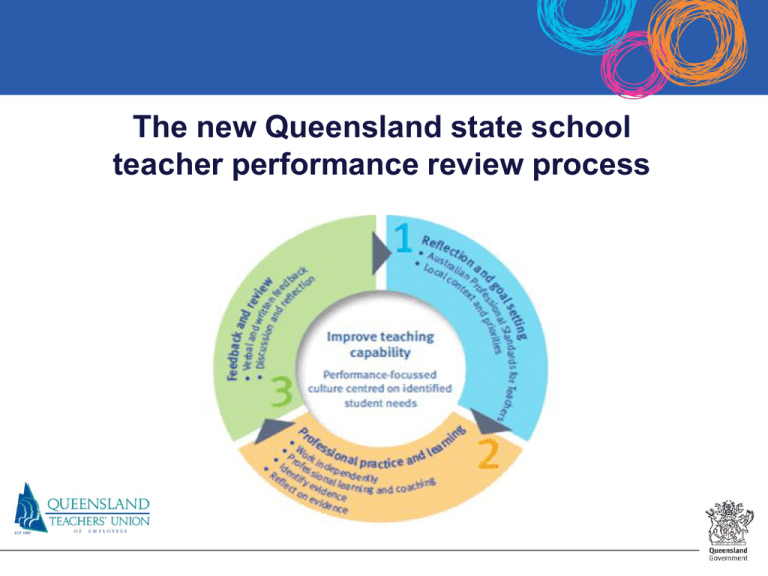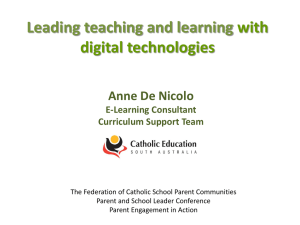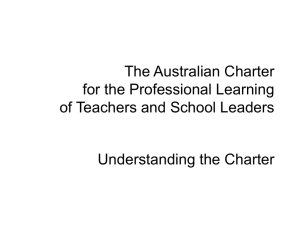Teacher performance review process
advertisement

The new Queensland state school teacher performance review process Queensland state schools teacher performance review process • What is the new State School Strategy? • What is the new teacher performance review process? • What does this mean for you? • What resources are available? 2 Every student succeeding State Schools Strategy 2014 – 2018 3 What is the new teacher performance review process? 4 • In July 2013, DET and the QTU agreed to a joint statement on the alignment of the Developing Performance Framework with the Australian Professional Standards for Teachers following agreement on their use by Ministers for Education nationally. • Every student succeeding State Schools Strategy 2014-2018: Teachers employing high quality, evidence-based teaching practices focused on success for every student. • DET and the QTU have agreed on a process, aligned with the Australian Professional Standards for Teachers, which is designed specifically for teachers from the commencement of 2015. • DET and the QTU is continuing to negotiate an annual performance review process for school leaders and classified officers. Old vs New Developing performance framework 5 Teacher performance review process • Four step process • Three step process • Linked to the QCT or DET Professional Standards for Teachers • Aligned to Australian Professional Standards for Teachers • Verbal or written plan • Written plan • Ongoing review and feedback – written and/or verbal • Ongoing review and feedback – written and verbal • Focussed on completing key work tasks, achieving career goals and undertaking professional development • Growing capability by strengthening the performance-focussed culture in school through on-going professional learning • Career and/or performance goals • Career and performance goals Teacher performance review process in action The Department of Education and Training in conjunction with the Queensland Teachers’ Union have released a joint statement supporting the new process. 6 Phase 1: Reflection and goal setting • Reflect on your school context and priorities • Reflect on and record your strengths and areas for development • Collaboratively establish three performance and development goals aligned to the Australian Professional Standards for Teachers • Record your agreed upon goals using the SMART model • Identify actions required to support achievement of your goals • Identify your indicators for success – How will you know you have achieved your goals? What evidence will you use? 7 Example: Koala State School Context: Koala SS is located in a metropolitan region and has a population of 750 students. It is a P–12 coeducational school. Students are from a diverse range of backgrounds including Indigenous and international. Our school focuses on the holistic development of students including physical, emotional, social and cognitive to provide a supportive learning environment for all. Priorities: The schools priorities for 2015 are: 1. Literacy with a specific focus on writing. 2. Upper two bands – all areas. 3. Implementation of School-wide Positive Behaviour Support. 8 Reflections To set authentic goals, it is important to reflect on current professional practices. What methods might you use to support assessment and self reflection? Does your school have an agreed process for self reflection? AITSL Self-Assessment tool 9 Following reflection Once you have completed a reflective process, you then need to identify a maximum of three focus areas for learning and development. These must be framed around the Australian Professional Standards for Teachers and can be from any domain. Koala State School example: Annual performance development plan Phase 1 & 2 — Goal setting, Professional practice and learning Focus areas for improvement Professional practice Standard 4: Create and maintain supportive and safe learning environments 4.3 Manage challenging behaviour Agreed performance and development goals Actions to develop capability Indicators for success Reflections, comments and notes during Phase 2 - professional practice and learning 10 How do I know my goal is SMART? 11 Goals aligned to Australian Professional Standards for Teachers and school priorities Koala State School example: Annual performance development plan Phase 1 & 2 — Goal setting, Professional practice and learning Focus areas for improvement Professional practice Standard 4: Create and maintain supportive and safe learning environments 4.3 Manage challenging behaviour Agreed performance and development goals Refer to Smart Goals Framework (Specific, Measurable, Accurate, Relevant, Time-phased) By the end of Term 2, I will research, develop and implement a range of strategies to effectively deal with challenging behaviours in the classroom so that student learning and well-being is optimised. Actions to develop capability Indicators for success Reflections, comments and notes during Phase 2 - professional practice and learning 12 Professional learning Relevant Collaborative Futures-focused Examples: – Professional learning teams – Peer observation – Moderating student work – Formal studies – Action research – Case discussions – Coaching – Mentoring – Modelling The Australian Charter for Professional Learning of Teachers and School Leaders 13 Actions to develop capability Koala State School example: Annual performance development plan Phase 1 & 2 — Goal setting, Professional practice and learning Focus areas for improvement Professional practice Standard 4: Create and maintain supportive and safe learning environments 4.3 Manage challenging behaviour Agreed performance and development goals Refer to Smart Goals Framework (Specific, Measurable, Accurate, Relevant, Time-phased) By the end of Term 2, I will research, develop and implement a range of strategies to effectively deal with challenging behaviours in the classroom so that student learning and well-being is optimised. Actions to develop capability Be specific • • • • Indicators for success Reflections, comments and notes during Phase 2 - professional practice and learning Identify and observe colleagues who apply a range of effective behaviour management strategies Access information and courses on behaviour management Reflect on and adapt behaviour management techniques and strategies based on individual student needs Arrange for peer and/or mentor observation and feedback of behaviour management strategies in lesson/s 14 Evidence • The teacher and their supervisor will identify and agree on appropriate evidence to measure successful attainment of goals. • Evidence supports teachers knowing if what they are doing is making a difference to improve outcomes for their students. • Teachers can use evidence from their daily practice in their reflection and feedback conversations. • A piece of evidence may be used to demonstrate one or more standard descriptors. • Evidence needs to come from a range of sources (indicated in the following table). NOTE: Teachers are not required to develop a portfolio of evidence. 15 Types of Evidence Evidence Category 16 Possible examples of evidence (taken from the AITSL guides) Teaching and learning programs • • • • term, semester or full year programs – unit plans Lesson plans Learning resources Learning tasks and activities Classroom observations • • Lesson observation notes Video clips of practice Student assessment and learning • • • • • Student conference outcomes Teacher records of student performance Assessment tools, tests, strategies Individual learning plans Individual student learning targets Data sets (short, medium term) • • • • Class achievement data Benchmark testing Attendance and behaviour Triangulation of data Reflection and feedback • • • • • Student conference notes Student feedback and survey data Parent-teacher interview notes 360° feedback Performance development plan Collaboration and communication • • • • Meeting logs Parent communication Involvement in school committees Community partnerships Professional learning • • • Learning journal Action research project Professional associations Guides to evidence QCT website (Proficient) 17 AITSL website Australian Professional Standards for Teachers What evidence will demonstrate attainment of my goals? Koala State School example: Annual performance development plan Phase 1 & 2 — Goal setting, Professional practice and learning Focus areas for improvement Professional practice Standard 4: Create and maintain supportive and safe learning environments 4.3 Manage challenging behaviour Agreed performance and development goals Refer to Smart Goals Framework (Specific, Measurable, Accurate, Relevant, Time-phased) By the end of Term 2, I will research, develop and implement a range of strategies to effectively deal with challenging behaviours in the classroom so that student learning and well-being is optimised. Actions to develop capability Be specific • Identify and observe colleagues who apply a range of effective behaviour management strategies • Access information and courses on behaviour management • Reflect on and adapt behaviour management techniques and strategies based on individual student needs • Arrange for peer and/or mentor observation and Indicators for success Refer to Documentary Evidence Guides • Identify and observe colleagues who apply a range of effective behaviour management strategies • Access information and courses on behaviour management • Reflect on and adapt behaviour management techniques and strategies based on individual student needs • Arrange for peer and/or mentor observation and Reflections, comments and notes during Phase 2 - professional practice and learning 18 Phase 2: Professional practice and learning 19 • Undertake professional formal or informal learning to support achievement of planned goals • Identify, collect and reflect on agreed evidence to support the achievement of your goals • Receive formal and/or informal feedback focused on improvement : ‒ Formal feedback no more than 4 times in the 12 month cycle Ongoing evidence to support learning Evidence: • Provides the basis for ongoing feedback, reflection and further development • Helps you to understand your progress in your identified performance goals • Assists you to identify any additional or different actions or modifications required to achieve your goals • Assists you to discuss your annual performance achievements with your supervisor 20 Phase 3: Feedback and review 21 • Throughout the process, as well during Phase 3, timely, and frequent improvement focused feedback provided • Full reflection of performance against agreed goals using multiple sources of evidence • Verbal and written feedback provided • Feedback may form the basis for subsequent performance reviews • Retention as an official record (signed and dated) Key documents • • • • State Schools Strategy 2014 – 2018 Joint statements Queensland state schools teacher performance review process Queensland state schools teacher performance review process – A step by step guide • Annual performance development plan template • Australian Professional Standards for Teachers • QCT: Transition to full registration – Providing evidence of practice – Evidence Guide 22 Resources • The Australian Charter for the Professional Learning of Teachers and School Leaders • Australian Teacher Performance and Development Framework • AITSL online teacher self-assessment tool • Looking at Classroom Practice • Executive Director: Organisational Transformation 23 AITSL Resources to support teachers To be used in conjunction with the joint statement. 24 Question Time 25







